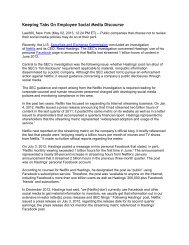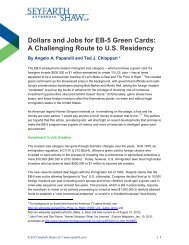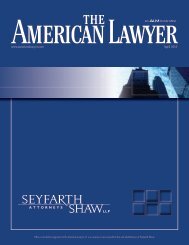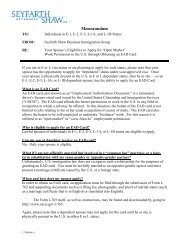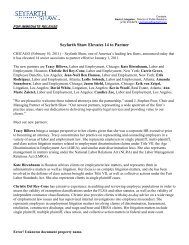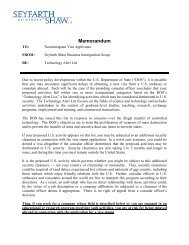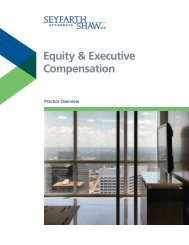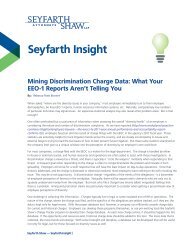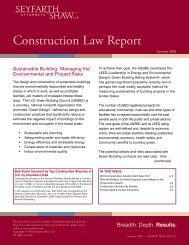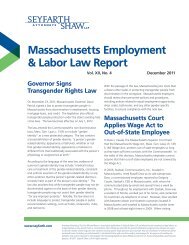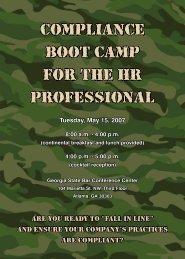Litigating California Wage & Hour and Labor Code Class Actions
Litigating California Wage & Hour and Labor Code Class Actions
Litigating California Wage & Hour and Labor Code Class Actions
Create successful ePaper yourself
Turn your PDF publications into a flip-book with our unique Google optimized e-Paper software.
analysis is instructive as to how another court may address the issue of concurrently<br />
exempt <strong>and</strong> non-exempt duties the next time it arises.<br />
The Murphy appellate court held that a manager could not satisfy the executive exemption<br />
where he spent 90 percent of the time working in non-exempt tasks even though he was<br />
continually keeping an eye on other employees <strong>and</strong> otherwise “managing” throughout the<br />
day while his h<strong>and</strong>s engaged in the same kind of work his non-exempt subordinates<br />
performed. The court reasoned that a manager is non-exempt when he is “a nominal<br />
coxswain who performed most of the time as an oarsman alongside the rest of the crew.” 26<br />
The court did not state, however, that time spent simultaneously directing other employees<br />
<strong>and</strong> engaged in non-exempt tasks counts purely as non-exempt time. Rather, the court<br />
suggested that the time spent in such a dual capacity may need somehow to be allocated<br />
between exempt <strong>and</strong> non-exempt time. 27 As such, time engaged simultaneously in exempt<br />
<strong>and</strong> non-exempt work might generate at least partial credit towards the 50 percent exempt<br />
threshold to qualify for the exemption. Further development in the case law is required to<br />
clarify this concept.<br />
C. The Administrative Exemption<br />
1. General Overview<br />
Like the FLSA, <strong>California</strong> wage <strong>and</strong> hour law recognizes an administrative overtime<br />
exemption. 28 To qualify for the exemption in the most common circumstances, 29 the<br />
employer must establish four elements:<br />
1) More than one-half the employee’s work time involves the performance of<br />
office or non-manual work directly related to the employer’s management<br />
policies or general business operations;<br />
2) The employee customarily <strong>and</strong> regularly exercises discretion <strong>and</strong> independent<br />
judgment in carrying out job duties as to matters of significance to the<br />
business. 30<br />
26<br />
27<br />
28<br />
29<br />
30<br />
Id. at 744.<br />
Id. at 744 n.8.<br />
See, e.g., <strong>Wage</strong> Order 7-2001 § 1(A)(2).<br />
There are alternative bases to qualify for the administrative exemption such as through regularly <strong>and</strong> directly assisting a<br />
proprietor or performing administrative function in a school system, but those alternative bases rarely come up in class<br />
litigation.<br />
Some courts mistakenly hold that employees must exercise discretion <strong>and</strong> independent judgment more than fifty<br />
percent of the time. In fact, the term “customarily <strong>and</strong> regularly” is defined in the FLSA regulations that are incorporated<br />
in the <strong>Wage</strong> Orders <strong>and</strong> “more than occasionally but less than constantly.” It is generally established by showing that a<br />
duty is carried out on a recurrent, non-sporadic basis. See Baca v. United States, 1 <strong>Wage</strong> & <strong>Hour</strong> Cas. 2d (BNA) 1066<br />
Seyfarth Shaw LLP | www.seyfarth.com <strong>Litigating</strong> <strong>California</strong> <strong>Wage</strong> & <strong>Hour</strong> <strong>Class</strong> <strong>Actions</strong> (12th Edition) 10



